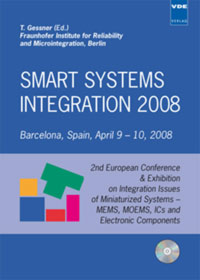Broadband Parameters of Compact FT Spectrometer based on Fabry-Perot Interferometer Integrated with Detector
Conference: Smart Systems Integration 2008 - 2nd European Conference & Exhibition on Integration Issues of Miniaturized Systems - MOMS, MOEMS, ICS and Electronic Components
04/09/2008 - 04/10/2008 at Barcelona, Spain
Proceedings: Smart Systems Integration 2008
Pages: 3Language: englishTyp: PDF
Personal VDE Members are entitled to a 10% discount on this title
Authors:
Manuilskiy, Anatoliy; Andersson, Henrik; Thungström, Göran; Nilsson, Hans-Erik (Mid Sweden University, ITM, Sundsvall, Sweden)
Abstract:
There is currently a large interest in research and development regarding compact and integrated Fourier Transform (FT) spectrometers exploiting a number of techniques. Previously the possibility to use a multi-channel wedge Fabry Perot closely integrated together with a detector to form a compact FT spectrometer have been shown [2]. This type of spectrometer can be manufactured for the VISNIR or IR wavelength range depending on the material and design of the wedge interferometer and type of detector. In this paper are discussed additional possibilities regarding manufacturing techniques and adjustment of the spectrometer parameters. The spectrometer consists of an array of Fabry-Perot interferometers attached on top of an array or matrix detector or alternatively on a Position Sensitive Detector (PSD). The principle is that collected and collimated photon radiation passes through a linear array or matrix of Fabry-Perot interferometers with changing thickness and thereby an interference patttern is formed on the backside of interfrometer that is recorded by a scanning or pixel detector. This interferometer array can be made in steps or as a wedge where the thickness changes linearly, cylindrically or as a combination of these shapes. The condition is that the angle should be small enough so that the period of the interference maxima for the shortest wavelength of interest is at least twice the distance between measurements. A Fourier transform of such an intensity distribution provides the spectra of incident light.


